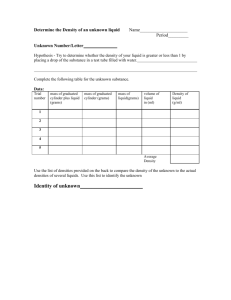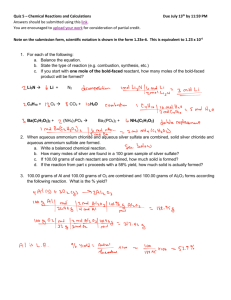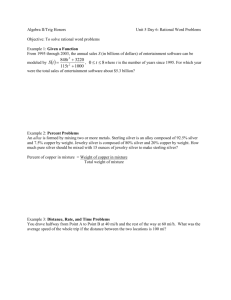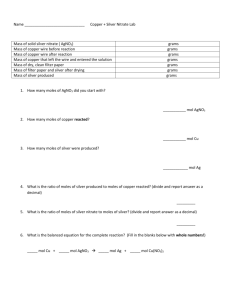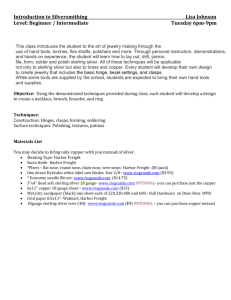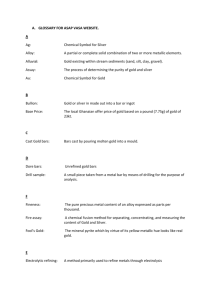Factor-Label Examples & Practice Problems
advertisement
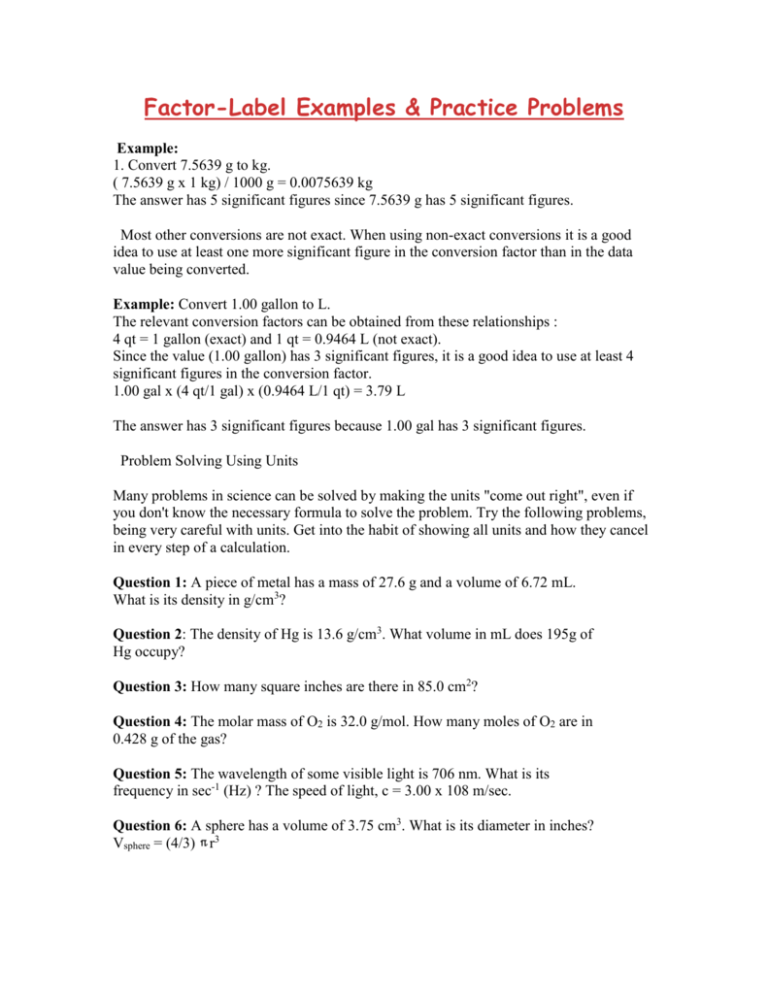
Factor-Label Examples & Practice Problems Example: 1. Convert 7.5639 g to kg. ( 7.5639 g x 1 kg) / 1000 g = 0.0075639 kg The answer has 5 significant figures since 7.5639 g has 5 significant figures. Most other conversions are not exact. When using non-exact conversions it is a good idea to use at least one more significant figure in the conversion factor than in the data value being converted. Example: Convert 1.00 gallon to L. The relevant conversion factors can be obtained from these relationships : 4 qt = 1 gallon (exact) and 1 qt = 0.9464 L (not exact). Since the value (1.00 gallon) has 3 significant figures, it is a good idea to use at least 4 significant figures in the conversion factor. 1.00 gal x (4 qt/1 gal) x (0.9464 L/1 qt) = 3.79 L The answer has 3 significant figures because 1.00 gal has 3 significant figures. Problem Solving Using Units Many problems in science can be solved by making the units "come out right", even if you don't know the necessary formula to solve the problem. Try the following problems, being very careful with units. Get into the habit of showing all units and how they cancel in every step of a calculation. Question 1: A piece of metal has a mass of 27.6 g and a volume of 6.72 mL. What is its density in g/cm3? Question 2: The density of Hg is 13.6 g/cm3. What volume in mL does 195g of Hg occupy? Question 3: How many square inches are there in 85.0 cm2? Question 4: The molar mass of O2 is 32.0 g/mol. How many moles of O2 are in 0.428 g of the gas? Question 5: The wavelength of some visible light is 706 nm. What is its frequency in sec-1 (Hz) ? The speed of light, c = 3.00 x 108 m/sec. Question 6: A sphere has a volume of 3.75 cm3. What is its diameter in inches? Vsphere = (4/3) r3 Question 7: A piece of aluminum foil is 0.010 mm thick. If it weighs 0.861 g, what is its area in cm2? The density of aluminum is 2.70 g/mL. Question 8: The radius of a copper atom is 2.556 . How many copper atoms could you line up in a row across a penny 1.85 cm in diameter? How many moles of copper is this? More Factor-Label Method Practice Problems: 1. Use conversion factors from the SI system to do the following conversions: a. 2.4 meters to centimeters b. 65.5 centigrams to milligrams c. 5 liters to cubic decimeters d. The density of a substance is 2.7 g/cm3. What is the density of the substance in kilograms per liter? 2. A car is traveling 65 miles per hour. How many feet does the car travel in one second? 3. The density of water is one gram per cubic centimeter. What is the density of water in pounds per liter? 4. How many basketballs can be carried by 8 buses? 1 bus = 12 cars 3 cars = 1 truck 1000 basketballs = 1 truck Practice Problem Answers: 1. a. b. c. d. 240 cm 655 mg 5 dm3 2.7 kg/L 2. 95 ft/sec 3. 0.45 lb/L 4. 32 000 basketball MORE ABOUT THE FACTOR-LABEL METHOD Metric-English Conversions: ALWAYS set up your problems, including labels: check each answer to be sure you have the correct number of significant figures and correct label. Reread the problem and estimate the correct answer to determine if your answer makes sense. Visualize the problem or draw a diagram when possible. Become aware of the metric labeling on products in grocery stores so that you become familiar with amounts given in metric units. Always tell yourself what type of measurement you are working with: volume, weight, or length. DO NOT CONFUSE mm (millimeters, which are length), with mL (milliliters, which are volume). Remember also that cm (centimeters) measure length, but cc (cubic centimeters) measure volume, and that the volume measured by one cc and one mL is the same: 1mL = 1cc SOME USEFUL METRIC-ENGLISH CONVERSION FACTORS: Ask your instructor which units you need to know. You only need to remember one factor for length, one for volume, and one for weight. Review writing both fractional forms of the conversion factor from the equality. LENGTH: 1 inch = 2.54 cm (exactly), or 1 in or 2.54 cm 2.54 cm = 1 in (This is the only exact English - metric conversion factor, the rest are approximations, and are accurate to the number of significant figures shown.) VOLUME: 1 liter = 1.06 qt., 1 qt. = 0.946 liters, 1 qt. = 946 mL Which is larger, a quart or a liter? ________ How many cc in a qt?______ WEIGHT: 1 lb = 454 grams, 1 lb = 0.454 kg, 1 kg = 2.2 lb Examples: Work these out for yourself, then check the solutions below: 1. Calculate the height of a 5 foot 10 inch man in m, mm, and cm. You know that 1 in = 2.54 cm, so first find the height in inches: 5 ft x 12 in = 60 in. 5 ft. 10 in. = 60 in + 10 in = 70 in. 1 1 ft Then convert to cm: 70 in x 2.54 cm = 177.8 cm, or 178 cm 1 1 in Then 178 cm x 1 m = 1.78 m 1.78 m x 1000 mm = 1780 mm 1 100 cm 1 1 m A man 5 ft. 10 in. tall has a height of _____in, _____m, _____cm, _____mm 2. Calculate the volume of a fish tank in L, mL, cc , qt. and gal. if it is 0.85 m long, 25 cm wide, and 20 cm high. (The problem is partly worked out , you can finish it.) You know that 1 mL = 1 cc ( 1 cm 3 ), so you should change the measurements to cm, find the volume in cm 3 , and then convert to L, qt, etc. V = 85 cm x 25 cm x 20 cm = 42500 cm 3 = 42500 cc = 42500 mL. = 42.5 L To get qt, you can either convert from mL to qt, or L to qt. __________qt 3. Calculate the number of kg, g, and mg in 1/4 lb of margarine (Again, you can finish the problem). You could start either by using the 454 g = lb, or 1 kg = 2.2 lb, as shown: 0.25 lb x 454 g = 113.5 g (114 g) 0.25 lb x 1 kg = 0.114 kg 1 1 lb 1 2.2 lb STRINGING TOGETHER CONVERSION FACTORS: As you saw above, there is often more than one way to set up a problem using conversion factors. You may have several factors to choose from (all should give the same answer, though). You may be more comfortable doing the problems in several steps, checking your answer at each step. Try putting together several steps, checking how units cancel. Example 1. Which is a better buy, a bottle of French wine at $4.00 per quart, or $3.00 for 750 ml? You could change liters to quarts and then find the price per quart of the $3.00 bottle. 750 ml x 1 qt = 0.793 qt 1 946 ml Then divide out $3.00 to get $3.78 (which turns out to be cheaper) 0.793 qt 1 qt You could probably do this in one step if you wrote down the desired units, and worked towards them, canceling the unnecessary units: $3.00 x 946 ml = $3.78 750 ml 1 qt 1 qt Example 2. Calculate the capacity in liters of a 10.0 gal. aquarium. Again, string together factors. 10.0 gal x 4 qt. x 1 L = 37.7 L 1 1 gal 1.06 qt Other factors could be used. PERCENT AS A CONVERSION FACTOR: Percent means parts per hundred . The parts can be in various types of units, such as money (budgets), or persons (election results). In chemistry, we use weight percent, the parts by weight of one material in a total of 100 parts by weight. (For example, a 12% NaCl solution would have 12 g NaCl per 100 g of solution). Sterling silver is an alloy (mixture of silver and copper) which is 92.5% silver and 7.5% copper by weight. One hundred pounds of sterling would contain 92.5 pounds of silver; 100 grams of sterling would contain 92.5 g rams of silver. Any weight units may be used, but the weight of the part and the weight of the whole must be in the same units. The percent composition of sterling tells us: 92.5 parts by wt. silver and 100 parts by wt. sterling 100 parts by wt. sterling 92.5 parts by wt. silver Set up your own conversion factors connecting the parts by wt. of copper and parts by wt. sterling. Example 1. If you have 80.0 lb. of pure silver, what weight of sterling can be made. TRY TO SET UP THIS PROBLEM FOR YOURSELF FIRST ! You need the conversion factor between silver and sterling set up so that you change the weight of silver to the weight of sterling. Since we are using lb of silver, your conversion factor weights will be expressed in lb , and you answer will be in lb of sterling: 80.0 lb silver x 100 lb sterling = 86.5 lb sterling 1 92.5 lb silver Your calculator will give you the number 86.486486, which needs to be rounded off to 3 significant figures. The 4 following the decimal point is rounded up to 5 because the number following it is larger than 5 (see text). ALWAYS CHECK YOUR ANSWER BY REREADING THE PROBLEM ! Here, you know that you are going to add copper to your 80.0 lb of silver to make the sterling. Therefore the weight of sterling will be greater than the weight of silver that you started with; and it is. CALCULATING PERCENTS: The definition is % = part X 100% whole Of course, the part and the whole must be expressed in the same units ! Example 2. An ore sample (mixture of copper, sand, and clay) weighing 8.5000 grams was analyzed and found to contain 0.510 grams of copper. Calculate the percent copper in the ore: % = part x 100% 0.510 g Cu x 100% = 6.00 % Cu whole 8.5000 g ore These calculated percents can then be used as conversion factors if needed. Expt. 2 Name: Section: More Practice: Conversion factors and percent. 1. Calculate the number of qts, gals., cc and mL in a 2 liter bottle of pop. If you serve 6 oz cups of pop, how many servings can you pour from a 2 liter bottle? (There are 32 fluid oz. in 1 qt.) ___________qts ___________gals ___________cc ___________mL ___________servings 2. Change 550 grams to kg, mg. and lb. ____________ kg ____________ mg ____________ lb 3. Calculate the cost of gasoline for a 420 mile trip if your car averages 20 miles/gal of gas, and the gas costs $0.95/gallon. (Hint: set up problem to give total gallons needed, find cost.) Gasoline for the 420 mile trip costs $___________ 4. French cooks usually weigh ingredients. A French recipe uses 225 grams of granulated sugar. How many cups are needed if there are 2 cups of sugar per pound: (Note that you are changing from units of weight, grams, to units of volume, cups. The conve rsion factor may not be the same for all ingredients.) 225 grams of sugar equals _____________ cup 5. A TUMS antacid tablet weighs 1.265 g, most of which is filler. Each tablet contains 500 mg of the active ingredient, calcium carbonate. a. What is the percent, by weight, of calcium carbonate, in each tablet? ___________ % b. What weight of calcium carbonate is needed to make 50 tablets? ___________ g c. How many tablets can be made from 15.0 g of calcium carbonate? _________ tablets 6. If 6.6% of a class earns A's, how many A's are earned in a class of 92 students? __________A's 7. A steer when slaughtered weighs 980.0 pounds. The weight of the meat prepared for sale is 590.0 pounds. What percent of the weight is meat? What percent of the weight is lost? A 980 lb steer is: _________ % meat _________ % lost 8. A person planned to spend $30.00 per week on food. If you should not spend more than 20.0% of your take-home pay on food, what should be his minimum weekly takehome pay? If $30.00 is 20% of your total paycheck, the total pay is: $ ___________ 9. A mixture contains 2.5 grams of ingredient A, 44.0 grams of B, and 8.5 grams of C. Calculate the percent of each ingredient. _____ %A, _____ %B, _____ %C 10. A sample of coal was found to contain 15.0% moisture (water). a. One ton of coal would contain ? pounds of water. (1 ton = 2000 lb). _________lb water b. 1.00 kg. of this coal would contain ? grams of water. _________g water 11. Rust is a compound which is 70.7 % iron, and the rest is oxygen. a. How many grams of iron and how many grams of oxygen are there in 680 grams of rust? __________ g iron __________ g oxygen b. How many grams of rust would contain 52.0 g of iron? __________ g 12. A food processing company wants each batch of ketchup to contain 70.0% tomatoes by weight. a. How many lb. of peeled tomatoes are needed to make 200 lb of ketchup? __________lb 13. An ore sample weighing 8.60 grams is found to contain 1.40 grams of copper. a. Calculate the percent copper in the ore __________ % Cu b. How many lbs. of copper are there in 2.00 tons of ore?* ___________lbs Cu c. What weight of the ore (in lb) would contain exactly 1.00 lb of copper? ____________lb ore 14. In an experiment, 5.6 grams of magnesium combined with oxygen to form 9.3 grams of magnesium oxide. Calculate the percent magnesium and the percent oxygen in the oxide formed. ____________ %Mg ____________ %O * Hint: in a. you found the % by weight of Cu. Your weight % tells the number of lbs of Cu per 100 lb of ore, or the number of tons of Cu per 100 tons of ore. You may use any weight unit, provided that the same unit is use for both the weight of the Cu and the weight of the ore.

